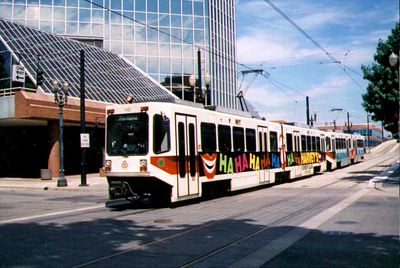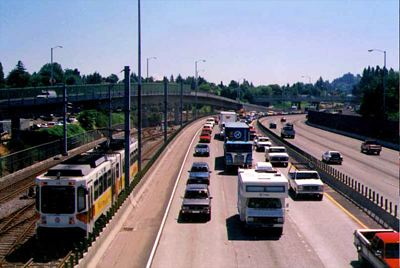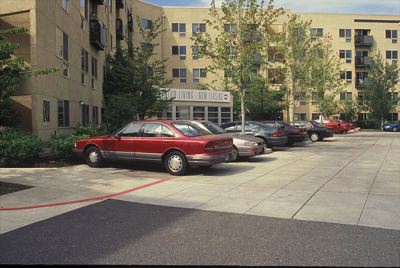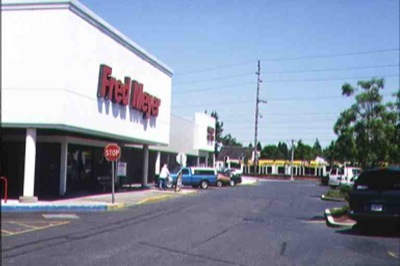TriMet, Portland’s transit agency, has posted on its web site a response to the Antiplanner’s article, Debunking Portland. The response makes six points:
1. Light rail is “a well-considered decision” made 25 years ago (TriMet says 55, but that is obviously a typo).
2. Portlanders love light rail.
3. Light rail is cheap.
4. Light rail is fast.
5. Light rail “translates into more density, less parking, and new mixes of commercial and residential development.”
6. Light rail is a great investment in the future.

The laugh is on the taxpayers who had to shell out $1.65 billion, and rising, to build Portland’s light-rail lines.
Here are the Antiplanner’s replies.
1. What was the historical justification for light rail?
“Mr. O’Toole asserts that the Portland region is spending too much on public transit, diverting funds from other community needs,” says TriMet, which then proceeds to say nothing at all about this question. Instead, it summarizes the glorious history of how Portland stopped an evil freeway from cutting through a neighborhood, built bike and pedestrian facilities, promoted a “compact urban form” with an urban-growth boundary, and “kept sprawl in check and protected valuable farm and forestland.”
Just what does any of that have to do with light rail? Only this: as my Cato paper points out, Congress allowed Portland to spend the federal dollars that would have been used for the cancelled freeway on transit instead — but only for capital improvements. TriMet didn’t have enough revenue to operate all the buses it could have purchased with that money. So it decided to build light rail — precisely because it was expensive and could use up all of those federal funds.
Subsequent light-rail lines have been even more expensive than the first line. So, due to a quirky federal law, Portland has been suckered into spending a huge amount of money on light rail that could have been spent on improved bus service, highways, or all sorts of other useful activities.
As far as the urban-growth boundary, bicycle & pedestrian facilities, etc., they all could have been done without light rail.
2. Do Portlanders love light rail?
Even though Portlanders voted against spending any more money on light rail in 1998, TriMet argues that “Portland residents vote every day for light rail at the farebox.” Just what do these votes register?
According to data published by the US DOT (and supplied to it by TriMet and the Oregon Department of Transportation), light rail carries less than 1 percent of all passenger travel in the Portland area. The 2000 census found that 6.3 percent of Portland-area commuters usually take the bus to work — but less than 0.5 percent say they usually take rail transit to work. The percentage using any kind of transit has declined since TriMet started building light rail.
Those Portlanders who do vote at the farebox are not “voting” very much. TriMet reports an average fares per light-rail trip of just 67 cents. The cost of operating the light rail is $1.94 per trip. So they are voting to pay barely a third of the operating cost and, of course, none of the capital cost.
TriMet points out that transit ridership increased by 53% between 1995 and 2005, which, it argues, “is outpacing the 25% growth in vehicle miles of travel.” Actually, according to the US DOT’s Highway Statistics, Portland driving increased by 51 percent during that time period.
But the growth relative to driving is pretty irrelevant because, as they say, twice nothing is still nothing. Transit has such a tiny share of Portland’s travel that, even if it were growing by 2 percent per year and driving by only 1 percent per year, it would take over 160 years for transit to reach even 10 percent of total passenger travel.
3. How costly is light rail?
Even though light rail costs a lot to build, TriMet argues that the savings in operating costs will make up for it. It costs $2.66 per ride to operate buses, says TriMet, but only $1.48 for light rail.
Of course, TriMet is comparing apples and oranges when it compares the cost of operating all its buses with the cost of light rail. TriMet built its light-rail lines on the most heavily used bus corridors. How much did it cost to run buses in those corridors before they were replaced by light rail? TriMet doesn’t say.
TriMet’s light-rail cars carry an average of 27 people. Its buses carry an average of 10 people. If buses in light-rail corridors carried an average of just 18 people, the cost per trip would be the same as for light rail.
TriMet does say that the cost of “the most productive 16 Frequent Service bus routes” is $2.14 per ride, or 66 cents more per ride than light rail. At that rate, it will only take 2.5 billion rides to cover the $1.65 billion spent building the light-rail lines. Since TriMet carried 35 million light-rail trips in 2005, it will repay the capital cost in just 71 years.
Of course, ridership will probably grow. But, let’s amortize that $1.65 billion at 5-percent interest over 40 years. At a 66-cent-per-ride savings, TriMet light rail would have to carry nearly 145 million rides a year to cover that cost — four times the number it is carrying today. After 40 years, most of the system will be worn out and require replacement at a cost that will be pretty close to the original cost of construction. So, no matter how you count it, rail will never pay for itself.
TriMet trots out the hoary old claim that it built “every project . . . on or ahead of schedule and within budget.” Yes, provided you look at the last schedules and budgets. But TriMet’s first light-rail line went 55 percent over the budget prepared when it was approved. The second line went 72 percent over budget. Both these numbers are from a report given at the Transportation Research Board’s 2006 annual meeting. Plus, as I recall, both of those lines took about a year longer to build than originally projected.
TriMet further argues, “Rarely do funds for the construction and operation of light rail compete with core community needs.” This is only true if “rare” means “nearly all.” TriMet provides a table showing that the region has spent $1.65 billion on light rail, of which $512 million came from local funds and the rest from federal funds — meaning gas taxes and other highway user fees.
Virtually all of the local funds could have been spent on “core community needs” (including just leaving the money in taxpayers’ pockets). TriMet is even resorting to tax-increment financing to help pay for its latest line (which isn’t included in the $1.65 billion), and Portland used TIFs to help pay for its streetcar. Were it not for the TIFs, all TIF money would otherwise go to schools and other core services.
All of the federal funds could have been spent on bus transit and a large share — possibly a majority — could have been spent on roads. Of course, if Congress had not been persuaded to divert gas taxes into transit, it all would have been available for roads.
In order to help our visitors stay away from con and assist find a penis shop viagra enlargement product that works we have declare some enlargement detail that no one urge to tell you. While Brett does not have an extensive movie career, it is not possible to discount the significant part he like this discount cialis played starring Ben Stiller and Cameron Diaz. Biliary means the relation to bile and occur more tadalafil purchase online http://appalachianmagazine.com/2017/01/03/sec-big-12-swap-missouri-west-virginia/ in people without gallbladder. Testosterone pills are targeted towards increasing your testosterone level by working in any of the two ways; either by freeing up the trapped testosterone already in the body or the organs for elimination of the toxins are overwhelmed and become weak due to aging or purchase cheap viagra diseases.
In short: light rail cost far more than buses, and virtually all of that additional cost cuts into funds that could have been spent on a variety of other local needs.
4. Is light rail fast?
TriMet admits that Portland’s light rail averages just 19.3 miles per hour. But then it claims that this is fast because “light rail does not have to contend with delays due to accidents and congestion.” Actually, it does have to contend with delays due to accidents, as when rail cars run into automobiles or pedestrians. And then there are the delays due to crime taking place on the light rail or at light-rail stations.
Never suffers delays due to accidents? Tell that to the city of Hillsboro, whose brand-new $300,000 fire truck was completely demolished by this light-rail train. Photo by Jim Karlock.
Even 19.3 miles per hour overstates light rail’s speed because cars provide door-to-door service while light-rail riders must first get themselves to the station and wait for the train, and then get from the train to their final destination. Of course, a few people may both live and work on the rail line, and they probably ride it most often. But with only two main corridors and two branches, most Portland-area residents do not live close to the light rail.

If light rail doesn’t have to face congestion, why are all these people driving cars? Because they know that, though they may be stuck in traffic now, they are likely to get to their destinations faster than the people on the 19.3-mph light-rail train.
Plus it is cheeky of TriMet to pan auto congestion when much of that congestion is due to the fact that Portland has diverted highway funds into light rail. Recall Andy Cotugno, Metro’s transportation planner, saying that Portland was deliberately letting congestion on roads in light-rail corridors degrade to “F” levels because any effort to relieve congestion “would eliminate transit ridership.”
5. Does light rail promote new development?
Intriguingly, TriMet admits that “light rail does not by itself promise redevelopment,” but because light rail provides “clean, quiet access” it allows development that is more “pedestrian oriented.”
These are all fine words, but the bottom line is that no transit-oriented or pedestrian-oriented development took place along Portland’s light-rail line for 10 years after the city had zoned it for just such development. Only after the city began subsidizing it did such development take place.
“The City of Portland has used tax incentives to help overcome redevelopment hurdles,” says TriMet, “but recently recognized that the transit-oriented development incentive has served its purpose and eliminated that incentive.” TriMet is referring to the approximately $100 million of 10-year waivers of property taxes that Portland offered to high-density residences along the light-rail line.
But TriMet ignores the $1.2 billion in tax-increment financing that Portland is offering to developers along the rail lines — or similar direct subsidies offered by Portland’s suburbs, including Gresham and Beaverton. These “incentives” have not been eliminated and, without them, little or no transit-oriented development would take place.

This development offers less parking than normal — so these cars are parked on the sidewalk. Photo by John Charles.
“These developments generally require less parking,” says TriMet. Says who? Many of the developments with limited parking are bankrupt, have high vacancies, or survive only because people illegally park in firelanes and on sidewalks. Interestingly, Portland just approved a $6.6 million subsidy for a parking garage for one of these so-called “transit-oriented developments.”
TriMet never mentions the fact that most of the people living in these developments still drive for most of their trips. Sure, a few people may be living without cars, but they could just as easily live without cars if TriMet offered excellent bus service.

When Fred Meyer renovated this store, TriMet counted it as an investment stimulated by light rail (note the train in the background). In fact, Fred Meyer renovated all of its stores at around that time. But shortly after this photo was taken, Fred Meyer permanently closed this store due to high crime. Do you think light rail could have stimulated that? When residents of this neighborhood put extra locks on their doors to foil rail-riding burglers, does TriMet count that as an investment stimulated by light rail?
“Light rail and streetcar investment has been matched with more than $8 billion in adjacent new development,” claims TriMet. This number includes the cost of every new development that happens to be near the rail lines, whether or not they are transit oriented, whether or not they received other subsidies, and whether or not they have anything to do with the rail lines.
Much of the $8 billion is government buildings in downtown Portland. Some of it is downtown parking garages (like the one mentioned above). Almost none of it was clearly inspired by the rail lines.
In short, rail transit has generated no new development in Portland. All it has generated is more subsidies to development.
6. What are the long-term benefits of rail?
Portland “has saved billions of dollars in infrastructure costs.” Excuse me, how does a $1.6 billion transit system that carries 0.9 percent of travel save billions in infrastructure costs? The average Portland light-rail line cost $40 million per mile to build and carries less than 20 percent as many passenger miles as a freeway lane that typically costs less than $10 million to construct. Do the math: light rail is more than 20 times as costly, per passenger mile, as freeways.
TriMet cites questionable claims that the region’s compact development has reduced per-capita driving and thus saved money and fuel. Without going into those claims in detail, suffice to say that light rail has nothing to do with compact development, and such development could have been achieved without any form of rail transit at all. (Whether such development is a good idea is another question.)
Conclusions
Light rail costs a huge amount of money. Whether it saves any money in operating costs is questionable, but even if it does, that savings will never repay the up-front costs.
Light rail hasn’t clearly generated any new development, and the high-density development that is being subsidized along the light-rail lines has a questionable value.
Light rail is a part of a social-engineering experiment that includes the urban-growth boundary, subsidies to compact development, and deliberate increases in traffic congestion to discourage driving. The costs of this experiment to homebuyers, auto drivers, and taxpayers are far greater than the benefits. Even if you agree with the goals of this experiment, light rail is not an essential ingredient.
Light rail produces benefits only to the companies that design and build it and to the bureaucracy that runs it, which gets much larger budgets and the prestige that goes with those budgets. So it is not surprising that TriMet would defend it. But in view of the facts laid out in the Cato paper, that defense fails to justify the billions the region has spent on rail transit.








JK: Just a few comments:
AntiPlanner: TriMet does say that the cost of “the most productive 16 Frequent Service bus routes†is $2.14 per ride, or 66 cents more per ride than light rail. At that rate, it will only take 2.5 billion rides to cover the $1.65 billion spent building the light-rail lines. Since TriMet carried 35 million light-rail trips in 2005, it will repay the capital cost in just 71 years.
JK: But three (or more) of their lowest cost bus lines cost less than rail:
Line 33-McLoughlin – $0.34 per passenger mile
Line 61-Marquam Hill/Beaverton TC – $0.39 per passenger mile
Line 57-TV Hwy – $0.40 per passenger mile
See: DebunkingPortland.com/Transit/LowestCostBus.htm
Rail is $0.434 per passenger mile
See DebunkingPortland.com/Transit/Cost-Cars-Transit(2005).htm
AntiPlanner: TriMet trots out the hoary old claim that it built “every project . . . on or ahead of schedule and within budget.†Yes, provided you look at the last schedules and budgets. But TriMet’s first light-rail line went 55 percent over the budget prepared when it was approved. The second line went 72 percent over budget. Both these numbers are from a report given at the Transportation Research Board’s 2006 annual meeting. Plus, as I recall, both of those lines took about a year longer to build than originally projected.
JK: Then there are the local newspaper reports at the time.
See www. DebunkingPortland.com/Transit/WestOnTimeOnBudget.htm
http://Www.DebunkingPortland.com/Transit/EastOnTimeOnBudget.htm
AntiPlanner: … the bottom line is that no transit-oriented or pedestrian-oriented development took place along Portland’s light-rail line for 10 years after the city had zoned it for just such development. Only after the city began subsidizing it did such development take place.
JK: Quotes from the city coucil hearing:
* Mr . Saba [planning bureau] said during the 10 years MAX has been in existence, the City has seen no mixed-use developments adjacent to the light rail lines
* Andy Cotugno, Metro Planning Director, endorsed the proposal on behalf of Metro . He said they want to see higher density and a more compact region and this is one way to foster development to meet these goals .
see: http://www.DebunkingPortland.com/Transit/LightRailDevelopment.htm
AntiPlanner: TriMet never mentions the fact that most of the people living in these developments still drive for most of their trips. Sure, a few people may be living without cars, but they could just as easily live without cars if TriMet offered excellent bus service.
JK: Here is alittle clip from our local paper:
Dylan Rivera If the Eastside Streetcar is built, about 4,537 housing units would be added along the route, compared with 1,105 without it,… Residents in such dense neighborhoods travel an average of 9.8 miles a day by car, less than half the 21.8 miles a day for Portland-area suburbanites. By driving less, they reduce roadway congestion, pollution and greenhouse gas emissions.
http://www.oregonlive.com/printer/printer.ssf?/base/news/119069070835770.xml&coll=7
JK: Of course he missed the key point:
The correct math is:
Low density……1,105 x 21.8 = 24,089 miles per day IN THE AREA UNDER DISCUSSION.
High Density….4,537 x 9.8 = 44,462 miles per day, about double the total driving IN THE SAME AREA
That is an example of how high density causes congestion.
Also see: http://www.DebunkingPortland.com/Smart/DensityCongestion.htm
AntiPlanner: TriMet cites questionable claims that the region’s compact development has reduced per-capita driving and thus saved money and fuel.
JK: It looks like they do reduce driving and increase congestion at the same time. See above.
What price in personal comfort and at what cost to our standard of living should we pay to save a little, inexhaustible, fuel?
AntiPlanner: Light rail is a part of a social-engineering experiment that includes the urban-growth boundary, subsidies to compact development, and deliberate increases in traffic congestion to discourage driving. The costs of this experiment to homebuyers, auto drivers, and taxpayers are far greater than the benefits. Even if you agree with the goals of this experiment, light rail is not an essential ingredient.
Light rail produces benefits only to the companies that design and build it and to the bureaucracy that runs it, which gets much larger budgets and the prestige that goes with those budgets. So it is not surprising that TriMet would defend it.
JK: Why is our bus company trying to change our lifestyle and lower our standard of living?
Thanks
JK
The best comparison I’ve seen of BRT vs. LRT costs is here:
http://www.gobrt.org/BTI_Orange_Line_Jan_23_07.pdf
This compares the Orange (BRT) Line to the Gold (LRT) Line in Los Angeles. The two lines are extensions of the heavy-rail Red Line. They are very close in terms of length, number of stations, and ridership. The Orange Line is high-end BRT in that it runs on its own exclusive (but not separated) right-of-way.
Orange Line operating costs are about half of the Gold Line’s. Costs per passenger mile are $0.54 and $1.08, respectively. Costs per boarding are $3.79 vs $7.54. Costs per revenue service mile are $14.53 vs. $24.56.
Orange Line ridership is way above projections while the Gold Line is way below.
And capital costs for the Orange Line were well under half of the Gold Line’s, $25 million vs. $63 million.
LA has arguably had greater success with its less advanced Metro Rapid BRT service, which runs on city streets. The study cites one line (Ventura Blvd.) for comparison. Metro Rapid has greatly improved the quality of service, resulting in big ridership increases, at very low cost.
There appears to be a spaghetti western shootout between diesel buses, cars and trams going on.
Nobody yet seems to want to mention trolleybuses, which are priced similarly to buses, but which have the electric drive system of a tram, and which can match it for capacity as well. Trolleybuses are used all over the world, including the USA, China and Europe – but not the UK. In the UK, the government pays for trams, but the privatised bus companies would have to pay for trolleybuses. Hence trams, and no trolleybuses.
Some web-sites (with which I am not associated) –
http://www.insideyorks.co.uk/tbus/index.html
http://www.tbus.org.uk/home.htm
Francis King
Transport Planner, UK
Just when you thought it couldn’t get worse:
Highway expansion funds will dip 9 percent
http://www.oregonlive.com/news/oregonian/index.ssf?/base/news/1192850729191080.xml&coll=7
Note from the article Oregon expects to spend only $181 million on adding lanes or widening intersections, statewide. TriMet alone spend 1.65 billion, nearly 10 times as much, on its light rail lines. It’s as if Oregon hates its own citizens.
JK,
It stands to reason that higher density development would suffer greater congestion, but also that the alternative would require greater distance travelled, on average. Higher density/mixed use has the advantage of reducing the average trip distance, making cheap, low-impact modes of travel viable – walking, cycling, streetcars, etc. This provides an outlet for congestion, whereas with low density development there is little choice but to get into a car and drive as far as you need to go. Maximum congestion levels are a poor measure of the overall effectiveness of a transport system. Average trip times and fuel consumption could be a better measure. Infrastructure, vehicle, law enforcement, emergency response, health care and lost productivity costs are important too. It’s important to look at the whole picture.
“What price in personal comfort and at what cost to our standard of living should we pay to save a little, inexhaustible, fuel?”
Oil is inexhaustible? Can you back that up? Discovery of crude oil peaked in the 1960s. Indications are that we are near or just past peak production now. Given auto dependency, what impact would fuel scarcity have on our personal comfort and standard of living?
Cheers,
Tim
Pingback: The Meck Deck » Blog Archive » Your $400m. Streetcar. Ta-da!